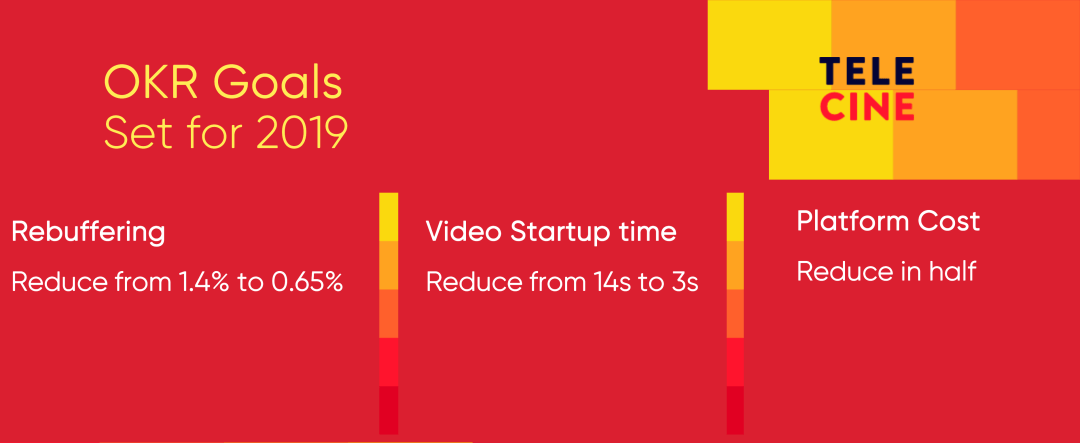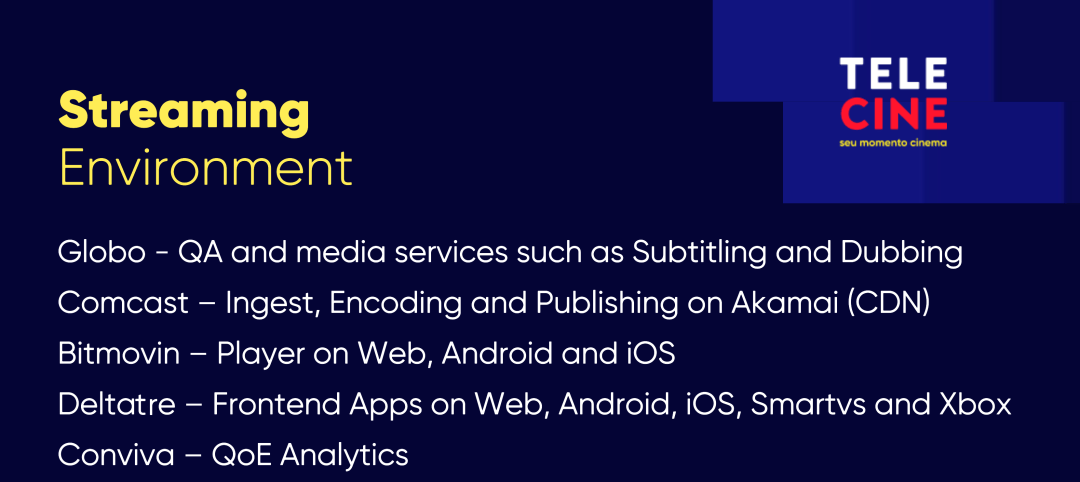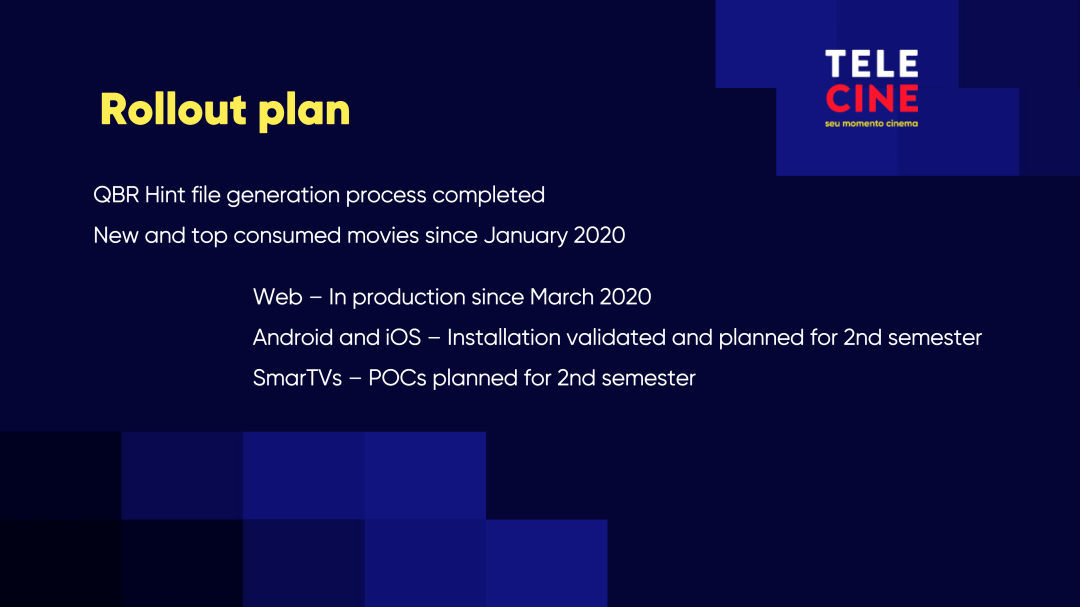Integrating SmartSight QBR into Your Video Workflow - MediaMelon Inc.
As covered in the previous post here Saving Bandwidth Costs & Improving QoE, the key to...
Telecine, Brazil’s leading movie streaming operator, is a joint venture of Globo Group with Paramount Pictures, Universal Pictures, Metro-Goldwyn-Mayer and The Walt Disney Company, and also streams content from Sony Pictures and Warner Bros. This case study will introduce Fabio Lima, who manages the Telecine Video Platform, and who selected MediaMelon SmartSight as a solution to some business challenges arising from substantial service growth during the COVID-19 pandemic.

In March, 2020, Telecine went live with MediaMelon SmartSight QBR aka SmartPlay solution. integrated with the Telecine encoding, delivery, and playback workflows, and drove a 42% cut in bandwidth usage while improving viewer quality of experience. The business improvements form this deployment helped Telecine manage the 4x increase in bandwidth during the lockdown associated with the COVID-19 crisis.
The core content in this post case is taken from a MediaMelon webinar during which which Fabio described his experience and the results that SmartPlay delivered. The headline benefit is a significant improvement in objective video quality for the service, contributing to greater customer engagement while saving 42% of bandwidth costs.
You can watch Fabio’s presentation from that webinar in this video - his section starts at the 35:00 mark. Our thanks and appreciation goes to the Telecine team for a collaborative approach to the implementation and their generosity and sharing the results achieved.
By way of introduction, SmartSight QBR aka SmartPlay is a streaming optimization solution that can reduce video service bandwidth costs by 35% or more while improving iMOS objective measures of consumer QoE. Even better, the solution works within any existing ABR content encoding/delivery workflow—including integration with existing device video players. Improvements can be achieved - as discussed in the presentation - even in workflows that have deployed content-adaptive encoding (also called per-title encoding).
For a more detailed description of the QBR approach—including the iMOS measurement—can be found in the companion series of blog posts here: Part 1, Part 2.
It's interesting to start by understanding Telecine’s operational goals. By way of background, Telecine replaced its CEO in 2018 and implemented development squads as defined in Spotify’s Agile Scaling Model. They also implemented some very aggressive “stretch” goals as shown in Figure 2, including dropping the re-buffering ratio from 1.4% to 0.65%, lowering the startup time for 14 seconds to 3 seconds, and cutting the platform operational cost in half.
One of the primary motivators for selecting additional optimization tools was to achieve the final goal of cutting platform costs in half.

It's also useful to understand Telecine’s operating environment (Figure 3). As mentioned, Telecine is owned by the Globosat division of Brazilian conglomerate Grupo Globo in conjunction with several Hollywood studios. Globo also runs multiple linear broadcast channels and acquires all content that plays on Telecine. Before handing the content off to Telecine, Globo performs a variety of quality assurance checks to validate that the media meets their standards, and makes sure that subtitling and the necessary language tracks are available for the contents.

After QA, all media goes to Comcast which encodes and packages the video using AWS Elemental MediaConvert and publishes and delivers to Telecine subscribers via the Akamai CDN. Telecine uses the Bitmovin player for Web (subscribers watching on computers via browsers), plus Android, and iOS viewers, which comprises about 50% of all sessions.
The other half is consumed by SmartTVs, gaming platforms, and OTT devices like AppleTVs. Currently, the front end apps for these devices are managed by Deltatre, but Telecine is in the process of developing these players internally to increase their agility regarding implementing and debugging new features. Lastly, Telecine uses Conviva for QoE analytics, which historically has provided the measurements used to set and validate the performance-related goals detailed above.
Prior to selection of new solutions, Telecine performed a proof of concept to validate the methodology of delivering the cost reductions they were seeking without degrading the quality of experience or introducing bugs or other instabilities into their ecosystem. This was performed by Telecine employees consuming QBR enabled content on a variety of devices and computers in many environments and many connection speeds.
For example, several users watched movies in traffic as that is a common use case, and tried mobile phones that were known to experience poor connection or video playback performance. During these trials, analytics tracked by Telecine proved that the bandwidth reductions QBR delivered were substantial without noticeable quality reductions, and Telecine selected the MediaMelon solution.
As shown in Figure 4, the installation involved two integrations with the overall SmartSight Platform:
The iMOS Content Analyzer that produced the iMOS hintfiles as an adjunct to the other components of the video origin file system. Telecine integrated the iMOS Content Analyzer with the Comcast publishing system via a watch folder, so content analysis and iMOS hintfile generation initiate when the CMS publishes a Content Information File in the Watch Folder. The Watch Folder Monitor application detects the new Content Information File, parses it, and submits a job request to the iMOS Content Analyzer. According to Lima, the Content Analyzer integration took less than 15 days to complete and debug after Comcast started on the integration.
The real-time device player system. The choice of the Bitmovin player—a long time MediaMelon solution partner—meant that integration the SmartSIght SDK into the player logic was very straightforward. Lima stated was “the easier portion of the whole installation,” which took less than two days.
As highlighted above, the source assets are sent from Globo to Comcast which encodes using AWS Elemental MediaConvert. To implement SmartPlay, Comcast needed to transfer ABR assets to the iMOS Content Analyzer service to validate the file and generate the iMOS hintfiles. In particular, Comcast needed to be assured that the integration wouldn’t interrupt the workflow or cause security-related issues.
By design, SmartPlay enables incremental rollout for both content and players. So, if iMOS hintfiles don’t exist for specific content, the QBR-enabled player logic uses standard ABR algorithms to play the video. If the iMOS hintfile does exist, and the QBR logic hasn’t been integrated with that specific device or player, the existing ABR player ignores the hintfiles and plays the video using standard ABR logic.

Telecine started the rollout slowly, deploying on the Bitmovin-based web player and creating iMOS hintfiles for new movies released each week. According to Lima, “for new content, we introduced five to ten movies a week and that was intentional. We made sure that we started small but with some relevant consumption. So, we started with new movies which are always a big hit for Telecine.”
Regarding the smoothness of the rollout, Lima continued, “We examined the initial results and we had zero issues. This is something I was really cautious about. We have had lots of issues on the platform overall, which is one of the reasons we are taking ownership of the code. I was very cautious about adding something new that had the potential to generate new bugs.”
Recounting the user response, Lima added, “So, we started slow and after a month or so we were free to move on because there were zero bugs and zero complaints about quality. I’m sure if the quality was not good we would hear about it and there were zero complaints.”
Telecine was in production with SmartPlay since early March 2020. About two weeks into the deployment, COVID-19 hit Brazil, the nation shut down, and Telecine traffic increased by 3X – 4X. Here’s where another SmartPlay feature kicked in to help Telecine manage the spike in demand. Specifically, operators can run SmartPlay using business rules tuned to specific goals; Quality, Bitrate, and Cost Save.
Both Quality and Bitrate modes improve quality and reduce bandwidth usage, with Quality mode delivering higher quality and lower bandwidth savings and Bitrate mode delivering greater bandwidth reductions and fewer quality improvements. In Cost Save mode, SmartPlay prioritizes bandwidth savings while maintaining quality constant (i.e. not attempting to improve it by buffering ahead).
Telecine launched SmartPlay in Quality mode. Then COVID-19 hit, and reducing outbound bandwidth became a priority for all large operators. As Lima recounts, “We had a discussion with the CEO and he was seeing all the other players cutting down bandwidth usage. For us, with SmartPlay, the solution was already there. So, I spoke with the MediaMelon team over Slack, and within a couple of hours, we changed from Quality to Bitrate mode and we started delivering much lighter video. Even though the growth related to COVID 19 affected us we had zero issues in addressing a new consumption behavior.”
Commenting on subscriber response to the change, Lima added, “Again, no users noticed the difference. We immediately saw the reduction of bandwidth in the analytics but there were no quality complaints from users and that’s something I had focused on in the beginning and throughout the rollout.”
Going forward, Telecine is focusing on taking the front-end player code in house. After that, Lima expects that it will be very easy to implement SmartPlay on Android and iOS, which are the other platforms being validated at this moment.
As shown in Figure 5, Lima next expects to start porting to Smart TVs but will manage these integrations carefully, commenting, “Smart TVs are about 50% of our consumption, so ideally making a good impact on Smart TVs will save a lot of bandwidth for us. But we need to be very cautious because on a big screen we need to make sure that the quality is as good as we can get. So, we are developing the code for Smart TVs and plan to launch several POCs in the second semester.”
During the webinar video, Lima displays multiple charts detailing the case study results. The first is the average bitrate chart shown in Figure 6. For reference, the blue line is all Telecine traffic, and the yellow line represents web browser viewing— essentially subscribers watching on computers via the Bitmovin player with QBR enabled. During the webinar, Lima points out that Comcast changed to AWS Elemental QVBR encoding in November 2019. Though QVBR is a form of per-title encoding, you see only a modest and slow reduction in bandwidth from November through March.
Telecine implemented SmartPlay in early March on the web browser clients, and you see a very profound and immediate impact on bandwidth in the yellow line. However, since the browser consumption was only about 10% of total Telecine traffic, the overall numbers represented by the blue line show only a small impact.
The deployment also clearly exhibited that SmartPlay also had a significant impact on re-buffering ratio for devices that included the QBR solution, as shown in Figure 7, with overall results again in blue and browser related traffic in yellow. As described earlier, one of Telecine’s stretch goals was to drop the re-buffering ratio from 1.4 to 0.65%. In Figure 7, you see that Telecine achieved this for the web clients soon after installing SmartPlay in March 2020. Recent system tweaks have reduced the re-buffering ratio down to 0.4% for the web clients, and 0.56% for overall traffic. Not surprisingly, Lima commented, “We are very happy with that result as well.”
The final results Lima shared related to bandwidth savings produced by SmartPlay over ten days in April 2020 on web clients web. As you can see in Figure 8, SmartPlay reduced the video bitrate by 42.17% while improving the iMOS score by 0.24. Commenting on these savings, Lima shared, “We chose April because of the huge consumption we had relating to COVID. So, you see that the reduction is clear. You see that that there are lots of gigabytes saved which is something that we are happy about.”
Lima commented on how these numbers were not just operational improvements - they also improved customer retention, stating, “But, bandwidth savings are not the first priority for us at the moment. We are making sure that the experience of users is optimal and retaining subscribers is a big plus. We want to make sure that everyone can play a Telecine movie and for that, we want our movies to be as light as possible and SmartPlay allows us to address that.”
Lima concludes with a look at Telecine’s goals for the platform and QBR going forward (Figure 9). As mentioned several times, Telecine wants to work to gain greater control of the web and mobile apps, and then to fine-tune performance and eliminate bugs.

SmartTV apps for Samsung and LG are next on the development roadmap. Since SmartTVs are such a major platform for consumption, Lima wanted to ensure that the “video experience is incredible.” Once the front end is finished on all these platforms Lima wants to continue to optimize playback as much as possible.
Lima takes considerable pride that goals relating to startup time and re-buffering ratios transitioned from seemingly unattainable stretch goals to day-to-day health metrics. To explain, he stated, “To us, these things seemed like stretch goals because we were delivering a really bad experience for users, but now they are considered normal health metrics, which for us is an amazing achievement. We’ll keep attempting to improve these metrics in the future, but it’s definitely not a major concern as it was in the past.”
Summarizing the benefits that the SmartSight QBR /SmartPlay deployment produced:
“We deployed SmartPlay to improve QoE and reduce costs after implementing a content-aware encoding solution we thought would deliver most of our data saving goals, but didn’t. In contrast, the SmartPlay results have been extraordinary! We reduced the average subscriber bitrate from 4 Mbps to almost 2.8 Mbps while improving quality and minimizing spikes in our web traffic. As a result of lower traffic, we’ve further reduced re-buffering and video start time. Overall, our QoE has gone up while our costs have gone down, which is a fabulous result.”

As covered in the previous post here Saving Bandwidth Costs & Improving QoE, the key to...
MediaMelon, a pioneer in content-aware streaming optimization, today announced Brazil’s Telecine...